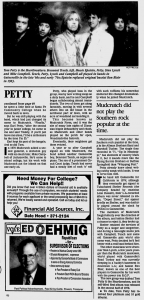The evolution of a rock star
By Bill DeYoung
Gainesville Sun - August 2, 1992
Tom Petty & the Heartbreakers are Gainesville's biggest cultural export.
Gainesville's most famous native son never went to the University of Florida. He spent plenty of time on the campus, however, playing loud and raw rock 'n' roll at fraternity parties and hanging out at free outdoor concerts and the few guest lectures that interested him.
For the one and only day job he ever had, he paddled a flat-hulled boat around Lake Alice and pulled up the water hyacinths that choked up the outflow pipes.
Mostly, Tom Petty hung out in music stores and stayed up all hours performing in bars. His father was sure Tom would never amount to anything.
The eldest of Earl and Kitty Petty's two sons, Thomas Earl Petty was born in Gainesville on Oct. 20, 1950. He discovered music while a student at Howard Bishop Middle School, at the age of 11. His uncle, Earl Jernigan, had been hired as assistant set decorator and properties man on "Follow That Dream," an Elvis Presley movie that was to be filmed around Ocala and in Yankeetown, just down State Road 40 near the Gulf of Mexico.
Uncle Earl took young Tommy and his little brother Bruce down to the Ocala set one afternoon. There, they watched Elvis, the camera rolling, park a car in front of the Ocala National Bank, several dozen times until he got it right.
They saw the star retire to his trailer and emerge in his white karate rope; in a roped-off area, Elvis and his martial arts trainer practiced breaking boards while a crowd of young girls stood to the side and squealed.
And that got Tom Petty's attention.
A facination with Elvis followed; he traded his favorite slingshot for a stack of somebody's sister's old 45s. He bought all of Elvis' albums at the dime stores in the Gainesville Shopping Center.
Petty's dad bought him a cheap guitar, and the budding musician taught himself some rudimentary chords. When the Beatles arrived in the United States in 1964, music became his driving passion (a particular irony in the wake of Petty's collaborations with George Harrison in the Traveling Wilburys).
His first band, the Sundowners, wore matching suits and Beatle boots. By the time he entered Gainesville high school in 1965, the band had evolved into the Epics; in 1967, they were one of the hardest-working groups in Gainesville, and traveled with their own sound equipment and psychedelic light show.
Earl Petty, an underwriter with National Standard Insurance, thought Tommy showed promise in art and should become an architect.
Tom went to St. Petersburg Junior College for half a year after his graduation from GHS in 1968; he spent a little time at Santa Fe Community College when he moved back to town.
But he was still playing with the band, which had just changed its name to Mudcrutch. "Finally," says Earl Petty, "after the second year in junior college, he came to be and said, 'Daddy, if you'll just leave me alone, I'll be a millionaire by the time I'm 35.'"
Earl kept his part of the bargain. And so did Tom.
In 1970 Mudcrutch added a second guitarist, a stick-thin guy with too much hair, Mike Campbell of Jacksonville. He'd come to attend college, but his work with Mudcrutch put the kibosh on that one early on.
Petty, who played bass in the group, was by now writing songs on a daily basis, and he and Campbell began collaborating almost immediately. The two of them got along famously, moving in with several others into an old house in the northwest part of town, with an acre of woodland surrounding it.
This became known as Mudcrutch farm, and it was the site of many late nights of Dionysian hippie debauchery an chaos, as Mudcrutch and other bands played on the porch for open, Woodstock-like festivals.
Eventually, their neighbors got them evicted.
A year or so after Campbell signed on with Mudcrutch, the band added another Gainesville boy, Benmont Tench, on organ and piano. The song of a prominent Circuit Court judge, Tench had never had a steady diet of rock 'n' roll with such ruffians; his somewhat sheltered life changed dramatically when he joined Mudcrutch.
Mudcrutch did not play the Southern rock popular at the time, a la the Allman Brothers Band and Marshall Tucker. The single they recorded in '71, "Up In Mississippi," has elements of country blues in it, but it sounds more like the Flying Burrito Brothers or Buffalo Springfield than "Whipping Post."
Petty already knew about writing catchy songs with hooks. It was to serve him well.
The band left Gainesville for California in 1974; although they eventually got signed to Tulsa-based Shelter Records (the company headed by musician Leon Russell), their L.A.-recorded album was never released (a single, "Depot Street," did appear briefly on Shelter, and was dutifully played around the clock by WGGG in Gainesville).
The members of Mudcrutch fought bitterly over the direction of the album, and before Shelter had a chance to reject it, they broke up.
Shelter retained the services of Petty as a singer and songwriter, and during a late-night studio jam with Campbell, Tench and some old other Gainesville pals who'd also come west, Petty decided he'd feel better with a real band behind him.
The other musicians were drummer Stan Lynch, a few years younger than the Mudcrutch musicians, who'd played with Gainesville's Road Turkey and ad currently sleeping in a buddy's basement in downtown L.A.; and bassist Ron Blair, known as one of the best players in Gainesville for his work with the power trio R.G.F.
The new group was dubbed Tom Petty & the Heartbreakers, and its self-titled first album was released in the second half of 1976.
To date, Tom Petty has received four platinum and 10 gold albums.


